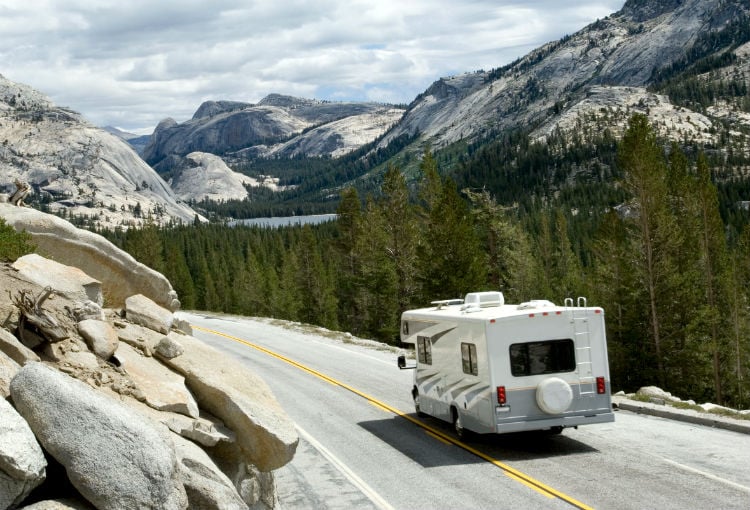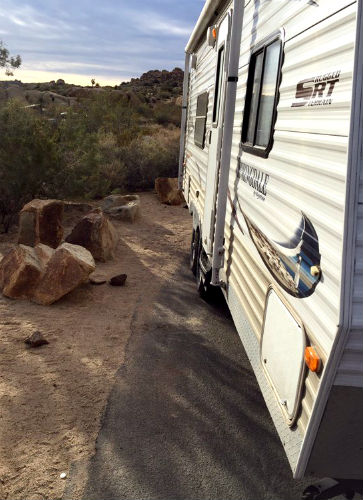Maneuvering an RV can be stressful for many travelers. Select campgrounds, gas stations, narrow country roads, and even urban streets present challenges in your RV.
However, regardless of the situation, finding yourself in tricky situations and getting through it are all part of the learning curve of RV travel, whether you’re seasoned RVer or a newbie.

No matter where your travels take you, side mirrors should be set so you can see a little bit of the side of your RV, immediately behind you and the lane next to you.
Become more comfortable maneuvering your RV:
- Every morning before you hit the road, be sure to check that your mirrors are properly set and clean. Your mirrors should be set so you can see a little bit of the side of your RV, immediately behind you and the lane next to you. This minimizes blind spots as much as possible.
- While you’re on the highway slow down and drive defensively. Always leave extra space between you and vehicles in front of you. Also, remember your length of your RV when changing lanes.
Here are some additional precautions when driving on urban side streets, getting fuel, visiting a roadside attraction or driving through a campground:
- Swing wide on corners. This helps to avoid clipping the curb, other vehicles, trees or other obstacles.
- Keep in mind the tail swing of your RV when turning sharply. The tail swing will always be out of the driver’s view.
- While pulling away from fuel pumps in stations, pay extra attention to the protective posts next to the pumps. Ask someone to spot your blind side if necessary. Accessing fuel stations with an RV can sometimes be challenging.

Always plan accordingly before you start to back up.
Key things to remember when backing up (no matter where you are):
- Backing up safely takes some concentration and preparation. Before you begin to back up, study where you plan to back up your RV. Take Note of any obstacles and plan accordingly. Remember to look for low hanging hazards like tree branches.
- Whenever possible, keep potential obstacles on the driver’s side and in direct view from the driver’s seat.
- If you are traveling with a companion, have them act as a spotter. Instruct them to stand where you can see them in the mirrors and agree of the meanings of hand signals in advance.
- Utilize a backup camera in your RV if you have one.
- Envision the required path for the rear axle to get where you want to go. Again, plan accordingly before you start to back up.
- While you are watching where the rear of your RV is going, don’t forget to turn your head to see where the front end of your unit is. Short posts or rocks below the drivers view along the edge of a campground road have damaged many RVs.
Practice, practice, and practice
Go find a large vacant parking lot, place some cones on the ground that allow you to practice maneuvering and backing up.
A couple of tipped over/smashed cones are way better than your RV. After practicing and getting experience on the road, you will soon find yourself adventurous enough to try a back into an RV space rather than rely on a pull-through site when visiting your next RV park.

We bought our first motor home, a 36′ class A, in August of this year. On our first long trip from Meridian ID to Marina CA we encountered two of the situations discussed in this publication. We found ourselves quickly coming upon a toll booth with too many cars coming up quickly behind us to get over to the far right. And we’re dinghy towing a car. I stopped short of the booth fearing that I was about to try to put 10 lbs of stuff in a 5 lb bag and it was going to get ugly fast. I asked my wife to get out and be my guide. The toll booth operator quickly came out and said she had to get back in the vehicle for her own safety. Good point. The booth operator kindly guided us through. We didn’t even rub our tires on the curb. Thank you to everyone behind us who was patient. We got no honking horns or one-fingered salutes as we got underway. Lessons learned; know where the toll booths are and stay to the right at all times. The second situation was on arrival at the RV Resort in Marina CA where we were spending the week. Beautiful place to stay but very very tight for big rigs. All spaces were back-in; no pull through’s. Uh oh…..I’ve never backed into a space let alone a very tight space. I’m happy to say I put our coach right where it needed to be with only a little maneuvering. I had both my wife and a Resort employee helping spot me. Lesson learned; take your time and be confident in your abilities; don’t be afraid to ask for help; get out of the coach and thoroughly scout out the site before attempting to park so you’re aware of the surroundings and potential obstacles; take your time and keep your cool; we place orange cones in the site to use as a guide. we also use hand held walkie-talkies to communicate since you can’t clearly hear someone outside at the rear of your coach and there’s only one hand sign I clearly understand anyway :-).
Our technique for backing is for me and my wife to do a walk-thru before starting to manoever, see what obstacles are present, agree where we want the vehicle to track, and where the driver’s side rear corner should eventually be placed. My wife stands on that spot, or on an intermediate spot if obstacles are present. She waits on the intermediate spot until I arrive, and then moves to the next target spot. My job is to place the driver’s side rear corner of the RV exactly where she is standing. Her job is to stand at that spot and ensure the path avoids all obstacles. We each take responsibility for our respective areas. If I have to “back-and-forth” to reach her position, I simply do that while she waits at the target spot. If she moves out of sight, I stop moving the RV until she reappears on the driver’s side. If she starts walking towards me, I know that she’s seen something that was not considered earlier and could be dangerous, so I stop moving and we discuss. She can see things that I can’t see, and vice versa. No verbal communication or hand signals are required. After developing this technique, we find it “entertaining” to see neighbours using wild hand signals with inaudible voice communication, while the spotter is standing on the blind side of the rig.
Thank you so much for the instructions about how you operate to backup your RV. Can’t wait to try it! It will take another 5 or 6 months more since the winter is seriously started in our area, already 6 inches of snow and still piling up. Thank you again.
Jack,
For those that don’t have a willing spouse, you can also use one of your leveling blocks (or similar item) as a “target spot”
We use the same routine, Jack, with the exception of walkie-talkies. I rarely say anything into the radio and my wife only gives updates to something we previously discussed or if (she thinks) I’m straying from our discussed plan. It works well. We also get some amusement as we watch and listen to neighbors swinging wildly off course and holler back and forth (and still not hear each other.
Similar to John’s post about using walkie-talkies, we use 2 cell phones to communicate between driver and spotter to cover blind spots while backing up. Picked this up from work where it’s often used with truckers backing into tight docks.
First, practice GOAl : Get Out And Look.
Second, Proceed as if you are the only person in the world. Don’t think or be intimated by those around you or those waiting to drive by. Most fellow campers are sympathic and patient. Take your time.
Third, establish a standard set of communications between you and your spotter. Mikie Boy
As a newbee land RVer (I’ve been “marine RVing” = my wife and I cruised the California and Mexican coast for 4 years = I’ve found that one of the enjoyable similarities is the entertainment derived of watching people anchor or park. Sometimes the entertainment is seeing goof ups, often it is seeing beautiful jobs. Both are entertaining, and sometimes educational.
Some things you learn real fast and real good!! Bought my first RV last October. A 30′ class C. I did a superb job of backing it in next to my car at home. Later when I pulled away I turned hard to the left. Yup, the tail swung into the car!! Rear passenger door and right rear quarter panel…DESTROYED!! Luckily, it didnt hurt the RV. Thankfully it was my car and not some one elses.
Bill, Tail swing is something many RVers don’t think about. Sorry you had to learn the hard way! Thanks for sharing.
RV Geeks have an excellent video on this very topic. Something we, as newbies, didn’t fully comprehend until we viewed this video. Fortunately we didn’t learn about this the hard way.